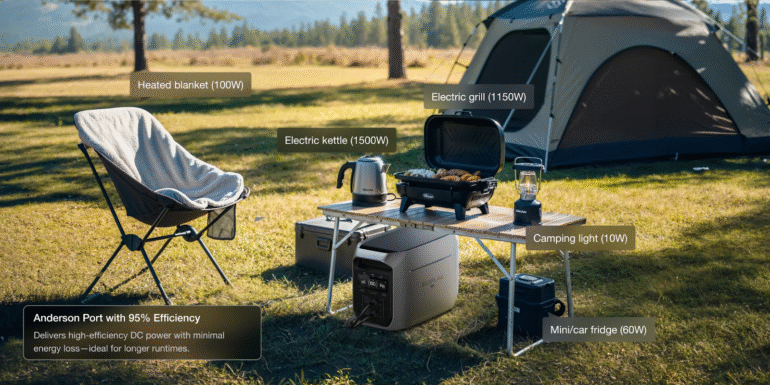Imagine you’re camping in Banff, the stars are bright, your phone’s charging, the lights are glowing — and suddenly everything shuts off. The battery’s dead. You thought it would last the whole night, but it didn’t.
That’s when most people realize they don’t really know how to estimate the runtime of their portable battery. Whether you’re using it for camping, home backup, or road trips, understanding how long your battery can actually power your devices is essential.
Let’s break it down step-by-step, in plain language, so you can make smart choices before your next adventure.
1. The Basic Equation: Capacity vs. Consumption
Every battery, whether small or large, is rated in watt-hours (Wh) — this number tells you how much energy it stores.
Every appliance or gadget you run consumes watts (W) — the rate at which energy is used.
To estimate runtime, use this simple formula:
Runtime (hours) = Battery Capacity (Wh) ÷ Device Power (W)
Let’s start with a simple example:
If your portable battery has 1,000 Wh and your LED light draws 10 W, the estimated runtime is:
1,000 ÷ 10 = 100 hours
That means you could theoretically run that small light for about four days before the battery runs out.
But real-life isn’t that perfect — and that’s where the next few sections come in.
2. Know Your Battery’s True Capacity
Not all watt-hour ratings translate directly into usable power. Every system has energy losses due to inverter efficiency, voltage conversion, and heat.
Most good-quality portable batteries — or a portable power station — operate at 85%–90% efficiency. That means you can realistically use about 850–900 Wh from a 1,000 Wh unit.
Example:
- Battery capacity: 1,000 Wh
- Efficiency: 90%
- Usable energy: 900 Wh
If your appliance draws 100 W, your true runtime would be:
900 ÷ 100 = 9 hours
So, when comparing products, don’t just look at the number on the label — consider efficiency, battery chemistry, and output losses too.
3. Understanding Battery Chemistry
Different battery types perform differently under load and temperature changes:
- Lithium-ion (Li-ion): Lightweight, common, but sensitive to cold weather.
- Lithium Iron Phosphate (LiFePO₄): Slightly heavier but far more stable, safer, and longer-lasting — ideal for cold Canadian winters.
- Lead-acid: Older technology, cheaper, but much heavier and offers less usable capacity (often only 50% of its total).
If you live in Canada or plan outdoor trips year-round, LiFePO₄ batteries are often the best choice for consistent runtime and durability.
4. Consider the Power Draw of Each Device
Every device consumes energy differently — and sometimes unpredictably.
Here’s an approximate guide to help you estimate:
| Device | Average Power Draw (W) | Runtime with 1,000 Wh battery (90% efficiency) |
| Smartphone (charging) | 10 | ~90 hrs |
| Laptop | 60 | ~15 hrs |
| Mini fridge | 80 | ~11 hrs |
| CPAP machine | 100 | ~9 hrs |
| Microwave | 800 | ~1 hr |
| Electric kettle | 1,200 | ~0.7 hr |
| Small heater | 1,500 | ~0.6 hr |
| LED light | 10 | ~90 hrs |
These are only estimates — real results vary based on how often devices cycle on and off, ambient temperature, and inverter load.
If you’re running several devices at once (say, a laptop + lights + fan), add up their wattages first, then divide the battery’s capacity by that total.

5. Continuous Load vs. Surge Power
Many appliances need an initial “kick” of extra energy when they start — that’s called surge power.
For example:
- A mini-fridge may run at 80 W but need 300 W for a few seconds to start the compressor.
- A power tool might draw 1,000 W but spike to 2,000 W at startup.
If your portable battery or portable power station can’t handle that surge, it might shut off to protect itself.
Always check both the continuous output rating and the surge (peak) rating of your battery. This ensures it can handle short bursts without tripping the system.
6. Account for Charging Losses and Efficiency
When recharging a portable power station, energy isn’t transferred perfectly — you lose some power through heat and conversion.
Typical charging losses range between 5% and 15%, depending on the method:
- AC wall charging: 5–10% loss
- Car charging (12 V): up to 15% loss
- Solar charging: 10–20% depending on sunlight and angle
These don’t affect runtime directly, but they influence how quickly you can get back to full charge — crucial during long trips or emergencies.
7. How Temperature Impacts Runtime
Cold weather is a quiet battery killer. When temperatures drop below 0 °C, battery chemistry slows down, reducing available capacity.
- At 0 °C, most lithium batteries lose about 15–20% capacity.
- At −10 °C, that can drop to 30–40%.
If you’re camping in Alberta or northern Ontario, store your battery indoors or inside the RV at night. Some portable power stations have built-in heating systems that automatically keep cells at optimal temperature.
At the other extreme, heat above 35 °C can also reduce efficiency, so avoid leaving your unit in direct sun for long periods.
8. Multiple Devices and Power Management
Few people run just one device at a time. In real life, your fridge, lights, and phone charger might all share the same battery.
To calculate this scenario:
- Add the power draw of all active devices.
- Divide usable capacity by that total.
Example:
- LED lights: 20 W
- Laptop: 60 W
- Fridge: 80 W
- Total: 160 W
If your battery’s usable capacity is 900 Wh → 900 ÷ 160 = 5.6 hours runtime.
This illustrates why power awareness is crucial. By turning off non-essential loads when not needed, you can easily double your runtime.
Some advanced portable power stations include apps that show real-time consumption and remaining time — a handy feature for active monitoring.
9. Using Solar Panels to Extend Runtime
If you’re off-grid for multiple days, solar panels can help recharge your system and effectively extend your total runtime.
For instance, a 200 W solar panel in full sunlight might generate about 1,000 Wh per day in summer. That’s enough to offset the energy you used overnight.
To maximize output:
- Tilt panels toward the sun (ideally south-facing in Canada).
- Keep them clean and free of snow or dust.
- Use an MPPT (Maximum Power Point Tracking) charge controller for efficiency.
When paired with a portable power station, solar input allows for semi-continuous operation — you can charge during the day and use stored energy overnight.
10. Real-World Testing Matters
Formulas are great, but nothing beats experience. Every setup, climate, and device combination is slightly different.
Once you’ve calculated your estimated runtime, test it at home:
- Fully charge your battery.
- Plug in the devices you plan to use.
- Run them continuously and record how long it lasts.
This hands-on approach helps you see how theory matches reality — and gives you confidence before heading into the wilderness or relying on your system during a power outage.
Bonus: Quick Reference Formula Recap
Here’s a cheat sheet you can bookmark or print:
| Step | What to Do | Example |
| 1 | Start with battery capacity (Wh) | 1,000 Wh |
| 2 | Multiply by efficiency (0.9 for 90%) | 900 Wh usable |
| 3 | Add up device power draw (W) | 100 W |
| 4 | Divide usable capacity by total watts | 900 ÷ 100 = 9 hours |
| 5 | Adjust for temperature & usage patterns | ~8 hours realistic runtime |
That’s it — simple math with real-world awareness.
Final Thoughts on The Runtime of Your Portable Battery
Estimating the runtime of your portable battery doesn’t have to be complicated. Once you understand the relationship between capacity, power draw, efficiency, and environment, you can plan every trip — or backup setup — with confidence.
For campers, van-lifers, and homeowners alike, the key is not just having a big battery, but using it wisely.
A reliable portable power station makes that even easier: it combines storage, inverters, and smart displays into one unit, letting you see exactly how much energy you have left and how fast you’re using it.
So before your next camping trip or storm season, take a few minutes to do the math, test your setup, and learn your true runtime.
What say you?
Thoughts on How to Estimate the Runtime of Your Portable Battery?
Let’s hear it!








